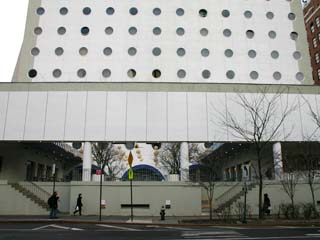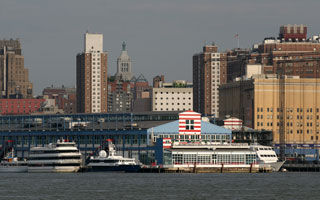363 W 16th Street, Google Maps
Telephone 212-242-4300
Trip Advisor review of The Maritime Hotel
Reservations
Make reservations for The Maritime Hotel at Hotels.com
Pictures of the Maritime Hotel

Guest rooms built for members of a sailors’ union – each with windows shaped like portholes – and later used by runaway teenagers and then by visitors from China are now occupied by hip visitors to New York in what is now the Maritime Hotel.

Maritime Hotel and Chelsea Piers. August 2005.
Description
Guest rooms built for members of a sailors’ union – each with windows shaped like portholes – and later used by runaway teenagers and then by visitors from China are now occupied by hip visitors to New York in what is now the Maritime Hotel.
The hotel is the latest incarnation of the white-tile 12-story structure that occupies the blockfront on the east side of Ninth Avenue between 16th and 17th Streets.
Its introduction signifies a new partnership on the New York hotel scene: that of the club and restaurant impresarios Sean K. MacPherson and Eric Goode, who offered the winning bid for the property, $19 million when it was sold in 2001, and the hotel developers Richard Born and Ira Drukier.
Mr. MacPherson and Mr. Goode are known individually for clubs in New York, like Mr. Goode’s Area, MK and the Bowery Bar; in Los Angeles for places like Mr. MacPherson’s Bar Marmont, Swingers and Jones; and jointly for the Park restaurant in New York, created from three former taxi garages on 10th Avenue near 18th Street.
No sooner did the two club operators complete the acquisition than they called Mr. Born and Mr. Drukier, developers, owners and operators of hotels including the Chambers and the Stanhope, as well as the glassy loft condominium towers on Perry Street designed by Richard Meier. Mr. Born and Mr. Drukier had also
bid on the old union building.
The building has an eclectic past. It was designed in 1966 for the National Maritime Union by Albert C. Ledner, a New Orleans architect. Browse Price Chopper Ad and Rite Aid Ad. It served as the annex to the union’s main building on Seventh Avenue between 12th and 13th Streets and included living quarters and instructional, medical and recreation space.
In 1987 it was converted into a home for runaway youths by Covenant House. Nine years later, it changed hands again, when it was sold to the New York Service Center for Chinese Study Fellows, which provided a variety of housing and educational services for Chinese students, artists and businesspeople.
The existing walls of the 120 guest rooms and 4 suites, each facing west and with a circular window five feet in diameter, are staying in place. The rooms, with new dark teak built-in furnishings and glossy white ceilings, are vaguely evocative of ship staterooms.
Resources
Community
Join discussion about Maritime Hotel